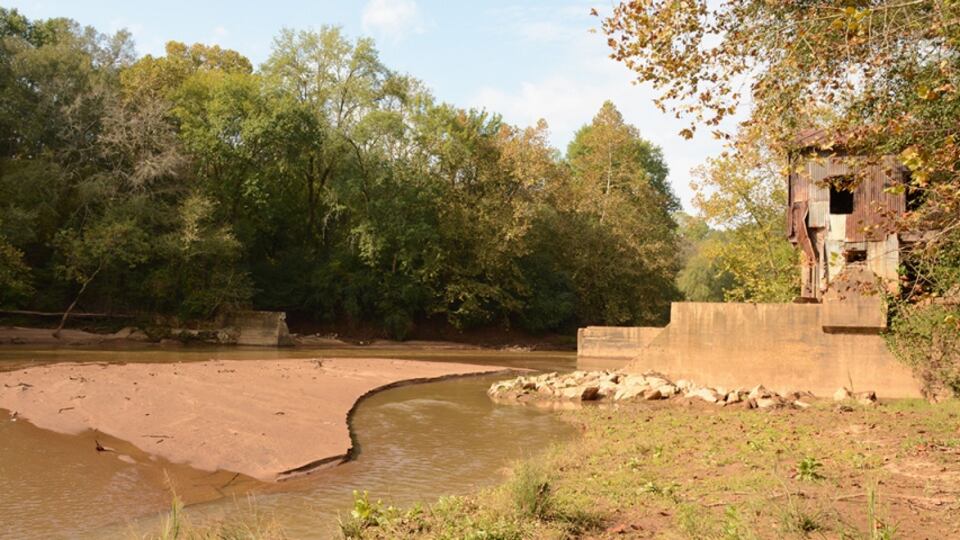The cranes and earth movers are gone. So is the concrete and rusted rebar.
Now all that’s left is the gentle sound of water lapping the edges of the Middle Oconee River where once it poured over White Dam.
And that is just how it should be.
“This has allowed me to bring people to the Middle Oconee and showcase it as it should be seen,” said Oconee Joe, a local river guide who has been able to grow his business now that a longer stretch of the Middle Oconee is open following the dam’s removal. “You can run from Tallassee to Barnett Shoals if you wanted to. The last 12 miles, from Ben Burton Park to the confluence with the Oconee, you really get to showcase that.”
This summer marks one year since faculty with the Warnell School of Forestry and Natural Resources pulled together the resources to remove White Dam, a 100-year-old structure located on the river behind Flinchum’s Phoenix, in Whitehall Forest. It was a complex procedure that took years of planning, including lining up funding, federal and state agencies to assist with the deconstruction, and water testing to observe the conditions of the river before and after removal.
We’re still a few months away from water quality results following the first year without the dam, but based on observations from recreational boaters like Oconee Joe, the river has already seen an improvement.
“The dam removal has been very beneficial in terms of water-based recreation,” he added. “I got to the University of Georgia in the late ’90s and I started paddling different sections, and just kept going as far downstream as I could—and that always presented some obstacles. … So we pretty much avoided that section.”
Improving connectivity, conditions
The dam was built to generate electricity—first for nearby Whitehall Mill, and later for UGA, which purchased the property in the 1930s. It was soon discontinued, though; its structure remained but gates that controlled water flow were removed, leaving two small openings that caused water to rush through.
These small openings posed several problems. It made it difficult for many fish, such as shiner, to get through and move upstream. Debris that couldn’t get through would accumulate and Warnell workers had to go out and remove it, posing safety hazards. The area was also dangerous for boaters.
Eventually, associate professor Jay Shelton, who led the effort to dismantle the dam, got the permits and required signatures, and in July of 2018 a crew from the U.S. Fish and Wildlife Service’s Aquatic Habitat Restoration Team arrived to begin the process.
Not all of it is gone, though. Because of its historic significance, said Shelton, the crew left the old power house as well as stone on either side.
The end result is a clear area for water to flow, with a nod to the past that can be viewed as you float through.
“The plan was based on aquatic connectivity in its broadest sense—we needed to do that in a way that kept everyone satisfied,” said Shelton. “We’re interested in the fish and invertebrates, but also we needed to balance ecology with economy and culture.”
Creating a gameplan
The dam removal was the first of its kind in Georgia because it required approvals from both federal and state agencies. But, Shelton said, there are many, many more obsolete dams that still exist and will need a similar approach in order to remove them.
That’s why he and other members of the Georgia Aquatic Connectivity Team want to help landowners learn from their experience. The team worked out the process through the White Dam removal, and the result was organized, streamlined and cost-efficient.
Based on the number of requests he’s received since then, Shelton said there is a real need for this information. Because the project requires participation from federal, state and nonprofit organizations—including the Environmental Protection Agency, The Nature Conservancy, the Southeast Aquatic Resources Partnership and Georgia Department of Natural Resources—it’s a lot for a private landowner to wrangle.
“We were basically the crash-test dummy,” he said. “These are big, complicated projects, and if we are going to be successful, it takes multiple partners. It really was a team effort.”
Shelton and other members of the Georgia Aquatic Connectivity team plan to have the guide finished by the end of the year. It will specifically focus on the procedure for removing dams in Georgia that are no longer in use. In the meantime, the team’s website, ga-act.org, serves as a hub for information and resources on aquatic connectivity.
The team is also working with the EPA to analyze water samples taken from fall and spring seasons to compare the data with samples taken before the dam was removed. Shelton plans to have a complete set of data later this fall.
A new sense of history
Oconee Joe pointed to a larger story of history—both of Athens and the United States—that can now be told through the removal of the dam.
Before its removal, paddlers were limited to certain sections of the river, often taking out their canoes and kayaks miles upstream from the dam. Dams create two obstruction issues: obviously, you can’t go over them, but going around often involves trespassing on private property.
Now, said Oconee Joe, he and others can float about 2 ½ miles through the State Botanical Garden of Georgia and then, as they float through the Whitehall property look up and see the remnants of an old steel railroad bridge. If you really look, you can spot the words “Carnegie” still printed on the sides—a nod to not only early industrialization of Athens, but of the entire country.
“It’s all flat water and is usually an easy float. And then you hit that old train trestle that used to go to Watkinsville,” said Joe, who plans tours on local rivers that highlight ecosystems as well as the history on their shores.
The waterway isn’t entirely clear—several miles downstream from White Dam is Barnett Shoals Dam, which includes an old powerhouse and a 48-foot drop. But through his own land purchases and agreements with other owners, Joe is able to cross this section on foot. This means it’s now possible for him to navigate around 60 miles of water on the North Oconee, Middle Oconee or Oconee rivers leading to Lake Oconee in Greene County.
“You’ll see something from the 1800s and then the dam from the 1900s—it’s just cool when you go through there and you get to see all this stuff,” added Joe. “And the dam’s removal has allowed us to take trips down into there. It’s opened up points beyond for now.”






